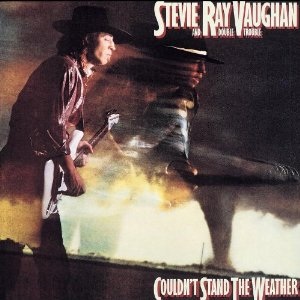Top Qs
Timeline
Chat
Perspective
Couldn't Stand the Weather
1984 studio album by Stevie Ray Vaughan and Double Trouble From Wikipedia, the free encyclopedia
Remove ads
Couldn't Stand the Weather is the second studio album by American blues rock band Stevie Ray Vaughan and Double Trouble. It was released on May 15, 1984, by Epic Records as the follow-up to the band's critically and commercially successful 1983 album, Texas Flood. Recording sessions took place in January 1984 at the Power Station in New York City.
Stevie Ray Vaughan wrote half the tracks on Couldn't Stand the Weather. The album reached No. 31 on the Billboard 200 chart and the music video for "Couldn't Stand the Weather" received regular rotation on MTV. The album received mostly positive reviews, with AllMusic giving it a four out of five stars. It received praise for Vaughan’s playing and highlighted songs such as "Voodoo Child" and "Tin Pan Alley", but received criticism for the lack of original songs.
In 1999, a reissue of the album was released which contains an audio interview segment and four studio outtakes. In 2010, the album was reissued as a Legacy Edition containing two CDs with a previously unreleased studio outtake and selections from an August 17, 1984, concert at The Spectrum in Montreal, Canada, originally recorded for the King Biscuit Flower Hour radio program.
Remove ads
Recording and production
During January 1984, Vaughan and Double Trouble spent 19 days at the Power Station recording studio in New York City. John Hammond was executive producer and supervised the sessions.[1][2] The album was produced by the band along with Richard Mullen and Jim Capfer. The album was engineered by Mullen and Rob Eaton.[1] Graphic artist Holland MacDonald designed the album cover art with assistance from Shostal Associates for the tornado image, a photograph of the 1957 Fargo tornado.[3]
Remove ads
Reception
Summarize
Perspective
The album was another commercial success for Stevie Ray Vaughan, selling 1,000,000 copies within five weeks. In a retrospective review, Stephen Thomas Erlewine of Allmusic wrote:
Stevie Ray Vaughan's second album, Couldn't Stand the Weather, pretty much did everything a second album should do: it confirmed that the acclaimed debut was no fluke, while matching, if not bettering, the sales of its predecessor, thereby cementing Vaughan's status as a giant of modern blues ... [However,] Vaughan didn't really push himself as hard as he could have, and the feeling that if he had, he would have come up with something a bit stronger.[13]
Robert Christgau wrote in his review that "Though he comes close sometimes, this Texan ain't Hendrix. But between earned Jimi cover and lyric refreshment, album two is almost everything a reasonable person might hope from him: a roadhouse album with gargantuan sonic imagination."[14]
Frank-John Hadley gave the 2010 reissue 4 stars in DownBeat.[12] He wrote, "The package now has a second disc that debuts a torrid set with his Double Trouble band at Montreal’s Spectrum the same year. In studio and onstage, he morphs pitch-bending into a visceral art form".[12]
Remove ads
Track listings
Summarize
Perspective
Original release
Details are taken from the 1984 Epic Records album liner notes;[15] reissues show several different songwriter credits.
1999 reissue bonus tracks
"SRV Speaks" is from a studio interview with Timothy White for Westwood One Radio. The remaining bonus tracks are studio outtakes from the sessions for the album.
2010 Legacy Edition 2-CD reissue
Remove ads
Personnel
Double Trouble
- Stevie Ray Vaughan – vocals, guitar
- Tommy Shannon – bass
- Chris "Whipper" Layton – drums
Additional personnel
- Jimmie Vaughan – rhythm guitar on "Couldn't Stand the Weather" and "The Things That I Used to Do"
- Fran Christina – drums on "Stang's Swang"
- Stan Harrison – tenor saxophone
Production
- Producers – Stevie Ray Vaughan and Double Trouble, Richard Mullen, Jim Capfer
- Executive producer – John H. Hammond
- Engineer – Richard Mullen
- Assistant engineer – Rob Eaton
- Cover art – Holland MacDonald
- Photography – Benno Friedman
1999 reissue
- Producer – Bob Irwin
- Executive producer – Tony Martell
- Mastering engineer – Vic Anesini
- Tracks 10–13 mixed by Danny Kadar
- Dialogue edited by Darcy Proper
- Research assistants – George Deahl, Al Quaglieri, Matthew Kelly, Jon Naatjes
- Art director – Josh Cheuse
- Editorial director – Andy Schwartz
- Liner notes – Bill Milkowski
2010 Legacy Edition issue
- Photography – Jean Krettler, Robert Matheu, James Minchen III
- Liner notes – Andy Aledort
Remove ads
Charts
Remove ads
Certifications
Notes
References
Wikiwand - on
Seamless Wikipedia browsing. On steroids.
Remove ads

